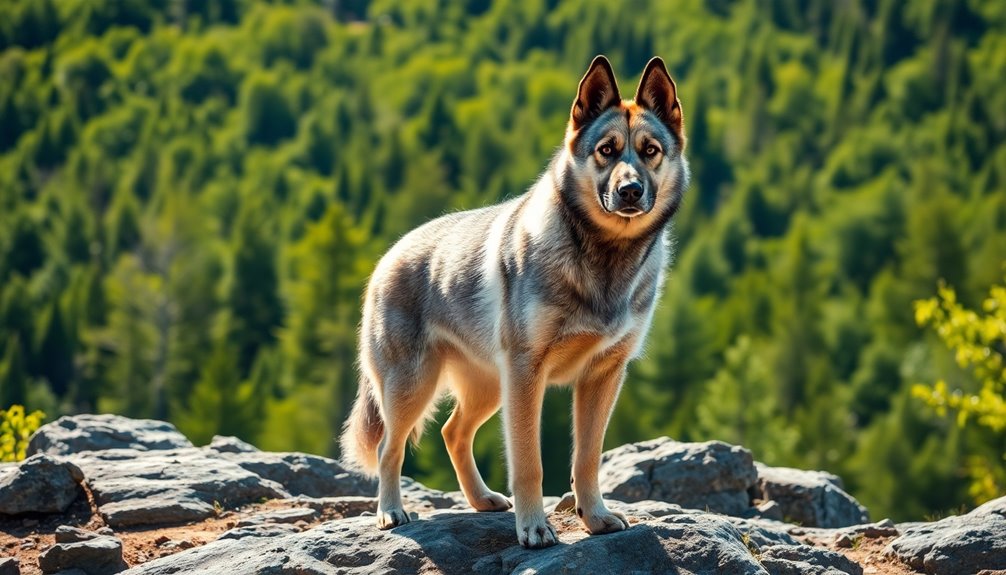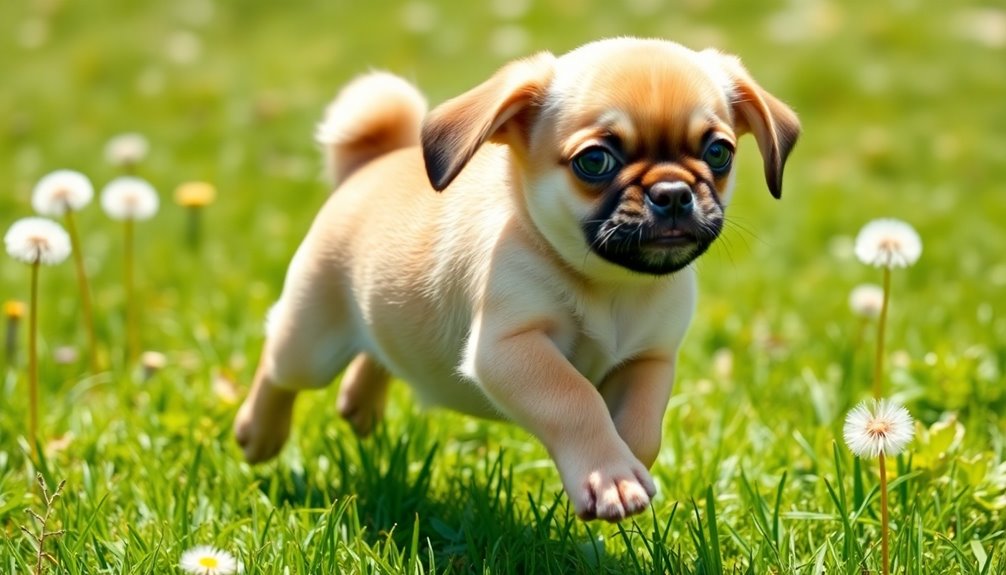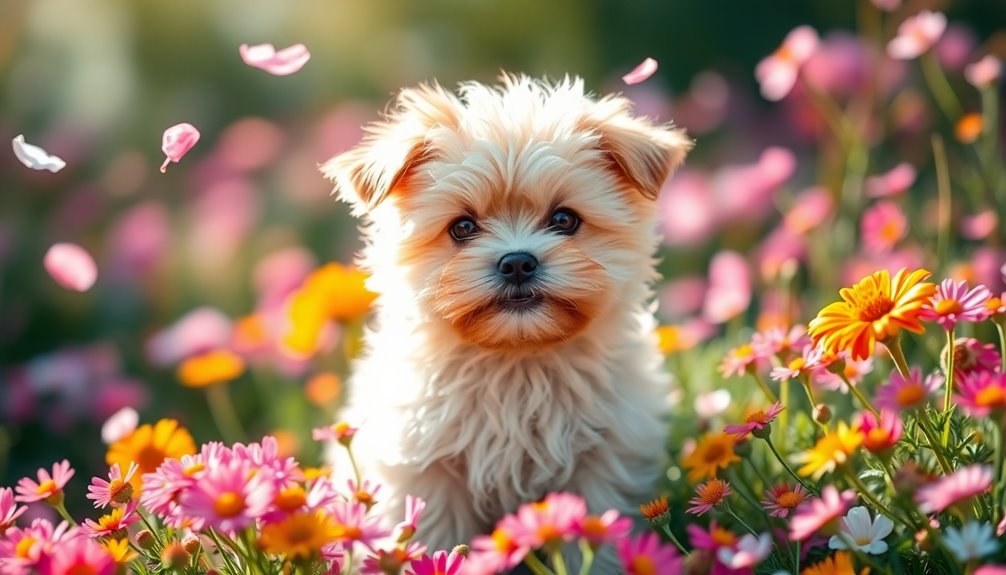The Norfolk Terrier is a spirited and friendly small dog that packs a lot of personality into its 11-12 pound frame. With a sturdy build and distinctive wiry coat, this breed is affectionate and courageous, forming strong bonds with families. They require daily exercise and enjoy playful activities, making them perfect companions for active owners. Training is essential, as these intelligent pups thrive with consistent socialization and positive reinforcement. Their lively nature makes them great for families, but be cautious around small pets due to their strong prey drive. Discover more about their history and care to see if they're right for you!
Key Takeaways
- Norfolk Terriers are affectionate and spirited, forming strong bonds with families and showcasing a playful nature.
- Weighing 11-12 pounds and standing 9-10 inches tall, they have a sturdy, compact build ideal for small living spaces.
- Their weather-resistant double coat comes in various colors, requiring regular grooming to maintain cleanliness and texture.
- Intelligent and eager to please, they respond well to positive reinforcement training and benefit from early socialization.
- Known for their strong prey drive, they excel in hunting small vermin and require daily exercise for mental and physical stimulation.
Introduction
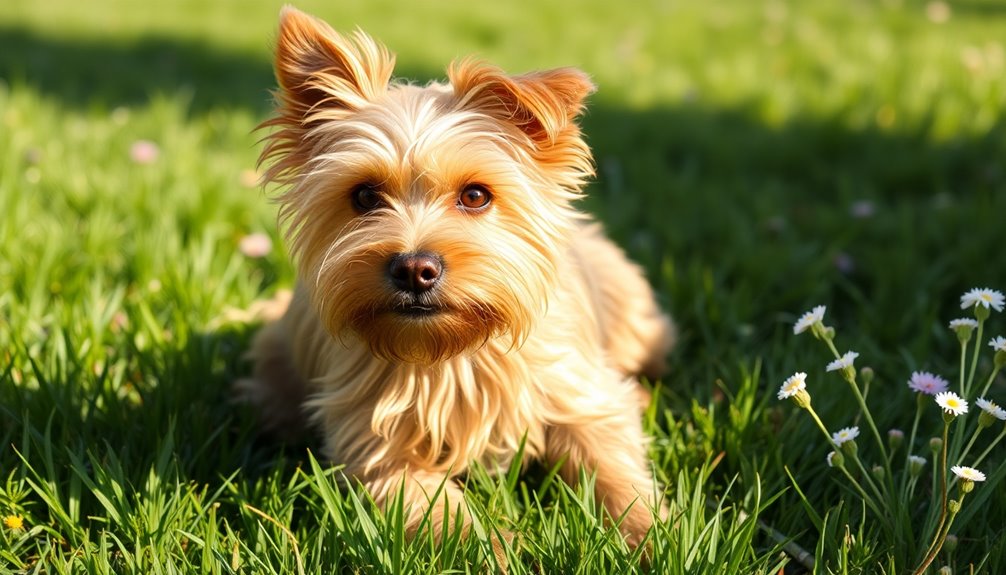
The Norfolk Terrier is a spirited little dog that packs a lot of personality into its small frame. Weighing between 11 to 12 pounds and standing 9 to 10 inches tall, this breed is small but sturdy, with a well-balanced, slightly rectangular build. Its wiry, weather-resistant double coat comes in various shades, including red, wheaten, black and tan, and grizzle, adding to its charming appeal.
Norfolk Terriers are known for their courageous and affectionate temperament. They form strong bonds with their families, showcasing a loving and independent spirit. These dogs are naturally inquisitive, always eager to explore new smells and sights. Their working role as vermin hunters in rural areas highlights their agility and determination.
However, their energetic nature means they require regular playtime and long walks to stay happy and healthy. While they can be sociable, Norfolk Terriers may initially be reserved around strangers. Their alertness makes them excellent watchdogs, but they might bark at unfamiliar sounds.
Proper socialization during their early weeks is crucial to ensure they thrive in various environments. With their intelligence and need for mental challenges, these dogs thrive on consistent training and stimulation, making them engaging companions for active families.
History and Origin
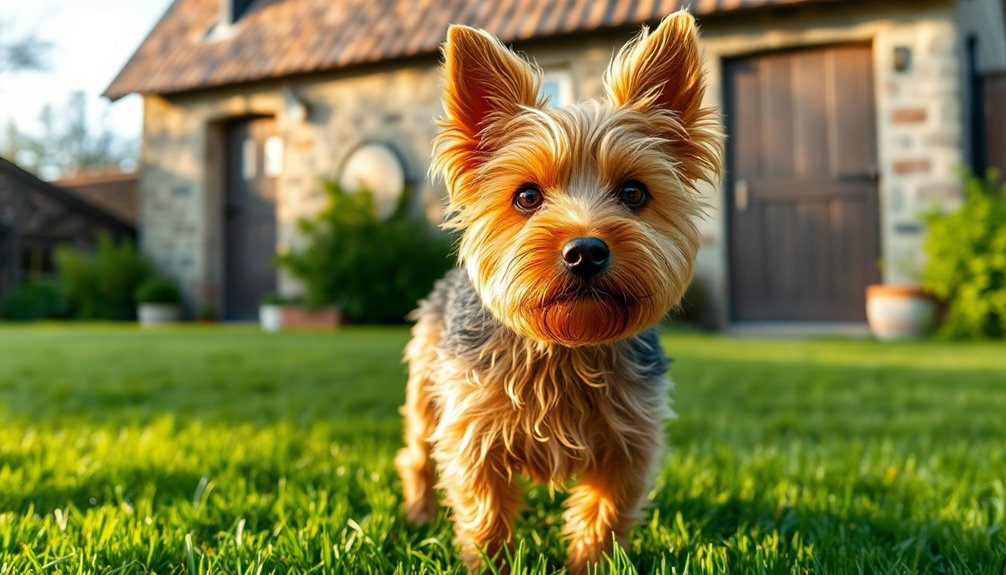
The Norfolk Terrier originated in East Anglia, England, during the late 19th and early 20th centuries. Bred primarily for ratting and small game hunting, these spirited dogs quickly became valued companions for rural households. You'll find that their history is deeply tied to the region's hunting traditions and the local terrier breeds that influenced their development. The breed's early history includes mixes of various terrier breeds, showcasing the diverse lineage that contributed to their unique characteristics.
Where and when the breed originated
Originating in the picturesque region of East Anglia, the Norfolk Terrier has a rich history tied to the area around Norwich, Norfolk's county town. Developed in the 1880s by British sportsmen and hunters, these spirited dogs were influenced by local terrier-like breeds and other breeds in the region.
You'll find that the breed's popularity soared among students at Cambridge University in the late 19th century, further cementing its place in the area. Early breeders like Frank Jones and E. Jodrell Hopkins played significant roles in refining the breed, particularly through their development of the Trumpington Terriers. Notably, Charles "Doggy" Lawrence also contributed to early breeding efforts.
The Norfolk Terrier was initially recognized as part of the Norwich Terrier breed but became distinct over time, particularly due to differing ear types—Norfolk Terriers have drop ears, while Norwich Terriers have prick ears.
The breed was first accepted by the English Kennel Club in 1932 and gained recognition as a separate breed in 1964. Additionally, the Norfolk Terrier has a medium to small litter size which influences their temperament based on upbringing.
In North America, it was recognized by the American Kennel Club and Canadian Kennel Club in 1979, marking its growing popularity across the pond.
Ratting and Small Game Hunting
Ratting and small game hunting have always been at the heart of the Norfolk Terrier's purpose. Originally bred to exterminate rodents in barns, these spirited dogs were essential for maintaining vermin-free farms. They developed from small working terriers, crossed with local breeds and short-legged Irish terriers to enhance their hunting abilities.
Norfolk Terriers possess a strong prey drive, targeting small vermin like rats, squirrels, and chipmunks. Their "charge and parry" style allows them to hold quarry at bay or encourage it to bolt. With a wedge-shaped muzzle and powerful teeth, they can quickly dispatch their prey. Notably, their working abilities have made them valuable companions in urban environments, where they adapt to modern hunting scenarios.
When they mark occupied dens, you'll notice their intense stare and stiffened neck, signaling their determination.
Today, these terriers participate in Earthdog trials and Barn Hunt events, showcasing their natural instincts. They excel in controlled hunting environments, thanks to their short hocks that let them navigate tight spots.
Even as they age, Norfolk Terriers remain productive ratters, often until around 13 years old. Their fearless and assertive nature, combined with their sociability, makes them both skilled hunters and beloved companions.
However, their strong prey drive means they're not suited for homes with small pets.
Physical Characteristics
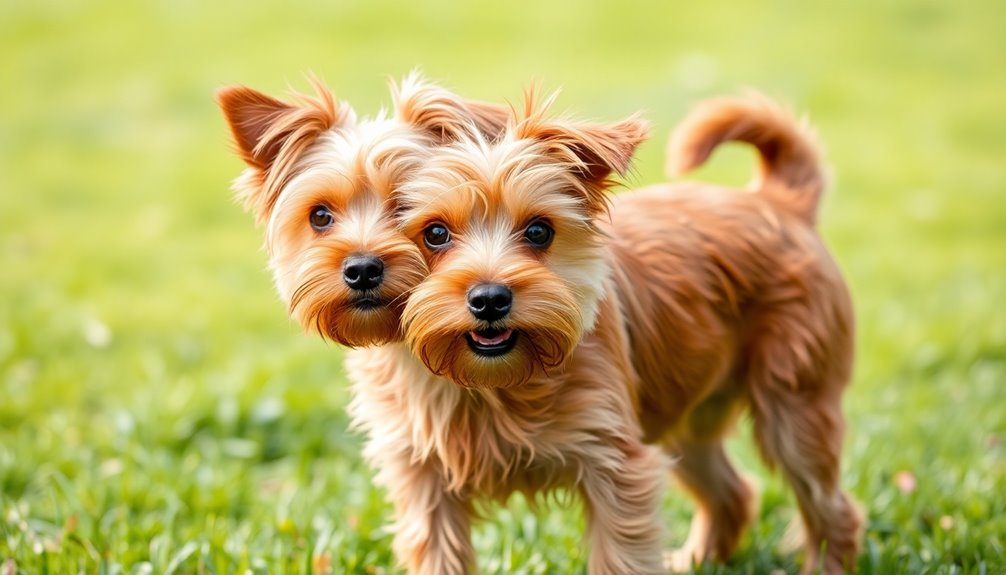
The Norfolk Terrier is a compact little dog, weighing between 11 to 12 pounds and standing 9 to 10 inches tall at the shoulder. Its wiry, weather-resistant coat comes in several colors, including red and black and tan, giving it a unique look. With a sturdy build and an expressive face, this breed exudes both charm and intelligence. This breed is particularly popular in Europe, showcasing its appeal in various dog shows and competitions.
Size, weight, and coat details
Norfolk Terriers are small but sturdy dogs, with males standing about 10 inches tall at the shoulder and females around 9 inches. Both genders typically weigh between 11 and 12 pounds, which is approximately 5 to 5.4 kg. Although they're compact, their well-balanced build gives them a robust appearance. Monitoring their weight is crucial for their overall health, as proper nutrition is foundational for maintaining a healthy weight.
By the time they reach one year old, they're fully grown, and at just 7 weeks, puppies weigh about 4 pounds. It's essential to monitor their weight, as they can range from a light 4.1 kg to a heavier 10.3 kg. A healthy Norfolk Terrier should have a distinct waist, and the skin should be easily pinched.
Their coat consists of a double layer, combining a harsh, straight outer coat with a soft, insulating undercoat, which helps them adapt to various weather conditions. Norfolk Terriers come in colors like shades of red, wheaten, black and tan, and grizzle.
Regular grooming is necessary to keep their coat clean and neat. With expressive dark eyes and drop ears that frame their faces, these dogs have a charming appearance that complements their spirited personality.
Fuzzy, Wiry Coat Texture
With a unique combination of textures, the Norfolk Terrier's coat features a hard, wiry, and straight outer layer that lies close to the body, providing excellent protection from the elements. Beneath this rough exterior, you'll find a soft and insulating undercoat that helps keep your furry friend comfortable in various weather conditions.
The fur around the neck and shoulders is longer and rougher, adding to the breed's distinctive look. You'll notice that the hair on the head and ears is short and smooth, accented by slight whiskers and eyebrows. Regular grooming is essential to maintain this unique coat; you'll need to brush it frequently to prevent matting.
Hand-stripping twice a year is necessary to remove the old coat, allowing the new weatherproof layer to flourish. Avoid clipping, as it softens the wiry texture you love. Thanks to the Norfolk Terrier's wiry double coat, shedding is minimal and manageable, typically happening twice a year.
This breed's strong prey drive means that supervision is essential during playtime to prevent any chasing of small animals. Make sure to trim around the feet and tidy up the chest and belly to keep your pup looking sharp and well-groomed. Proper coat management ensures your Norfolk remains healthy and comfortable.
Temperament and Personality
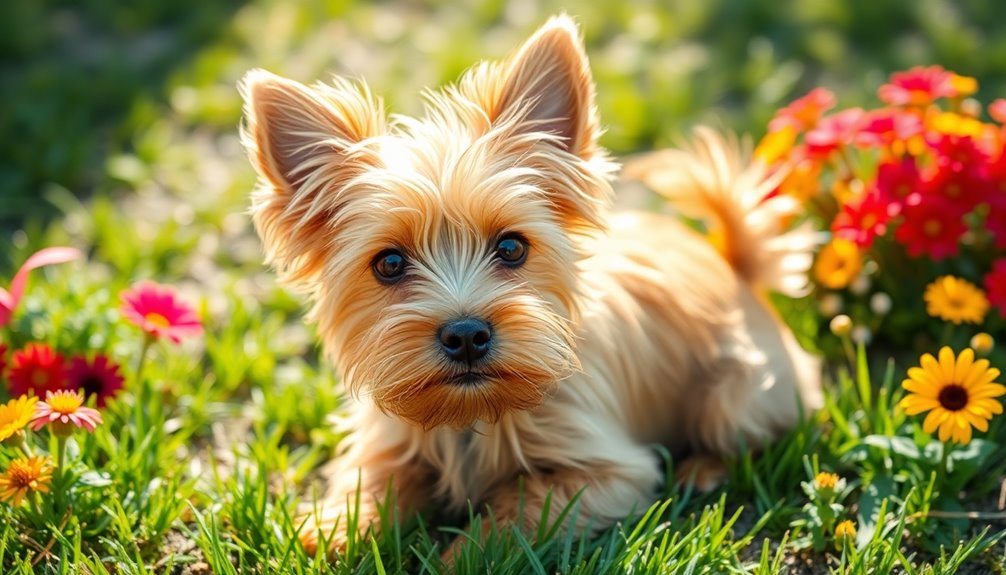
When you think of a Norfolk Terrier, picture a playful and spirited companion that brings joy to any household.
These dogs thrive in family settings, making them perfect for individuals and families alike, while also getting along well with other pets. Their energetic nature and friendly demeanor ensure they'll fit right into your life, bringing warmth and enthusiasm wherever they go. Additionally, their high adaptability allows them to comfortably adjust to various routines and living environments.
Playful and Spirited Demeanor
Bursting with energy and enthusiasm, Norfolk Terriers are known for their playful and spirited demeanor. With medium to high energy levels, they thrive on daily physical activity and mental stimulation. You'll need to provide regular walks, engaging play sessions, and interactive activities to keep them happy and healthy. Their lively nature reflects the pace of your environment, making it essential to prevent boredom, which can lead to unwanted behaviors like chewing and digging.
These dogs are courageous, affectionate, and self-assured, always ready to explore new sights and smells. Their inquisitive and curious nature makes them charming companions, eager to investigate the world around them. It's important to note that Norfolk Terriers have a natural inclination to chase small animals, so supervision during outdoor activities is essential.
While they're naturally alert and make excellent watchdogs, you may need to manage their tendency to bark at unfamiliar sounds or sights.
Norfolk Terriers are intelligent and quick learners, but they do have an independent spirit. Consistent, positive reinforcement training is crucial, as they can be stubborn without proper guidance. Early socialization and training will help you shape their playful spirit into well-rounded behavior, ensuring a delightful companion for years to come.
Suitability for families, individuals, or other pets
The Norfolk Terrier makes a wonderful companion for families, individuals, and even other pets, thanks to its friendly and adaptable temperament. If you have kids, this breed is generally good with them, but supervision is essential to ensure safety during playtime. Their patient and loving nature makes them a great choice for families, provided you guide and socialize them properly. Additionally, Norfolk Terriers are known for their clever and active nature, which allows them to engage in various activities with children.
For individuals, Norfolk Terriers thrive in city life or small gardens and can form strong bonds with their owners. They enjoy being part of daily activities and require regular exercise, ideally one to two hours of walking each day. While they can be left alone occasionally, they prefer companionship.
When it comes to other pets, Norfolk Terriers can coexist peacefully with familiar dogs, but they may struggle with unknown ones. Early socialization is key to harmonious relationships.
However, introducing them to cats or small animals can be tricky due to their strong prey drive. With careful introductions and boundaries, they can learn to coexist, but training and socialization are vital for success.
Health and Lifespan
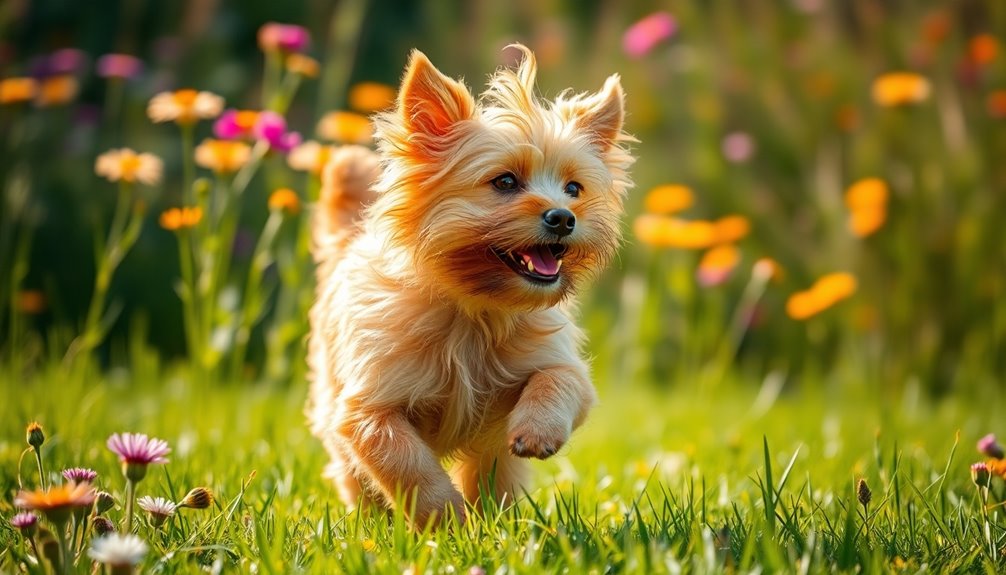
When it comes to your Norfolk Terrier's health, understanding their typical lifespan and common health concerns is crucial.
With a lifespan averaging between 12 to 16 years, proper care can help your furry friend live a longer, healthier life. Regular check-ups, a balanced diet, and preventive measures can make a big difference in maintaining their overall wellness. Additionally, it's important to be aware of their high susceptibility to dental disease, as this can significantly impact their health if not addressed early.
Typical lifespan of the breed
Norfolk Terriers often thrive for an impressive 12 to 16 years, reflecting their spirited nature and robust health. While their lifespan typically ranges between this timeframe, it can vary from 8 to 14 years due to factors like genetics, diet, and environment. Some fortunate individuals may even live into their late teens, showcasing the breed's longevity as a notable characteristic. Additionally, the average lifespan is influenced by hereditary health issues, which can lead to premature deaths in some cases.
To maximize your Norfolk Terrier's lifespan, proper care is essential. Regular health check-ups help monitor their well-being, while a balanced diet significantly impacts their longevity.
Daily exercise, including walks and playtime, keeps them fit and healthy. Environmental factors, such as living conditions, also play a role in their overall health.
Don't underestimate the importance of grooming; regular brushing prevents matting and maintains coat texture. Early socialization and consistent training using positive reinforcement methods ensure good behavior and interactions.
Common health concerns or genetic predispositions
Health concerns and genetic predispositions can significantly impact your Norfolk Terrier's quality of life and longevity.
One major issue is mitral valve disease (MVD), affecting approximately 60% of Norfolk Terriers in America. MVD often begins with a heart murmur and can lead to heart failure if not monitored regularly. Weight control and fatty acid supplementation can help manage symptoms.
Orthopedic problems, like hip dysplasia and luxating patellas, are also common. Hip dysplasia can cause severe pain and lameness, particularly in overweight dogs. Early identification through X-rays is crucial, and severe cases may require surgery.
Eye issues, such as Primary Lens Luxation (PLL) and Progressive Retinal Atrophy (PRA), can lead to blindness. Regular eye exams are essential to catch these conditions early.
Additionally, dental disease is prevalent, which can lead to infections that shorten your dog's lifespan. Norfolk Terriers are also prone to skin conditions like ichthyosis, which can be challenging to manage but is non-life-threatening.
Skin problems, liver disorders like portosystemic shunt (PSS), and susceptibility to infections like parvo and distemper also pose risks.
Keeping your Norfolk Terrier healthy involves being vigilant about these common health concerns.
Tips for maintaining health and wellness
To keep your Norfolk Terrier thriving, focus on a balanced approach that encompasses diet, exercise, grooming, and regular veterinary care.
Start with a high-quality, balanced diet tailored to your dog's age, size, and activity level. Consult your veterinarian to determine portion sizes and dietary needs, and keep an eye on their weight to prevent obesity.
Daily exercise is crucial for maintaining your dog's physical and mental fitness. Regular walks and playtime are essential, along with interactive toys to meet their energy requirements. Your Norfolk can thrive in an apartment if given daily walks and frequent play.
Grooming is also vital; brush their wiry double coat regularly to prevent matting. Consider professional hand-stripping to maintain coat texture, and trim or strip their coat twice a year.
Don't forget to keep nails short and teeth clean to avoid dental issues.
Lastly, schedule regular vet check-ups to monitor health. Clean their ears weekly to prevent infections and follow the vaccination schedule recommended by your vet. Incorporating mindfulness techniques can also enhance your dog's overall well-being and reduce stress.
Considering pet health insurance can also be a wise choice for unexpected medical needs.
Care Requirements
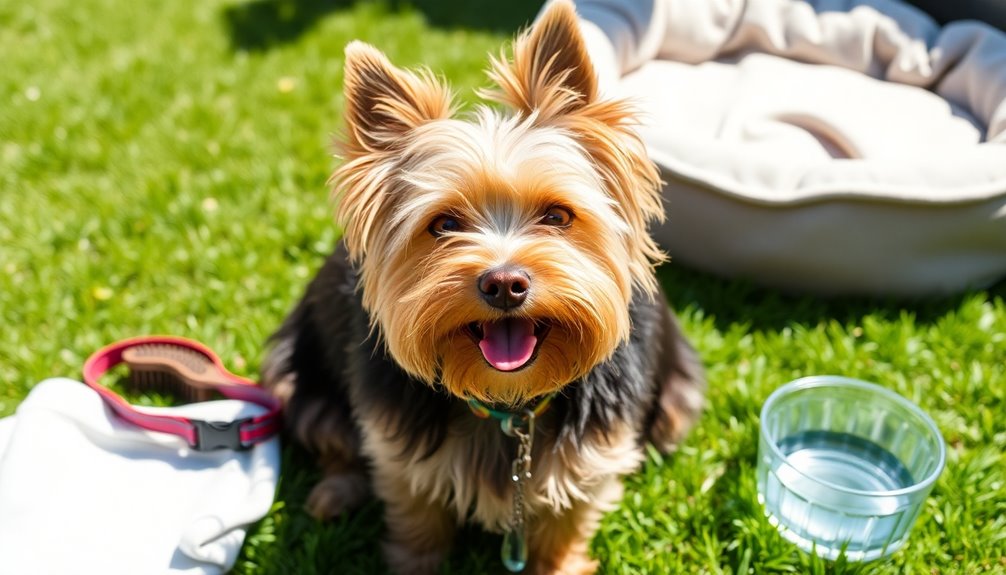
Caring for your Norfolk Terrier involves regular brushing to keep their wiry coat in top condition and maintaining their high energy levels with daily exercise. You'll need to provide around 30 to 60 minutes of physical activity, along with a balanced diet tailored to their age and health needs. Ensuring they have ample mental stimulation is also crucial to prevent boredom and promote overall well-being.
Regular Brushing Required
Regular brushing is essential for keeping your Norfolk Terrier's coat in top shape. Their wiry, weather-resistant double coat requires consistent grooming to maintain its unique texture and vibrant colors, which can range from wheaten to black and tan.
Although Norfolk Terriers don't shed much, you should brush them at least once or twice a week to prevent matting and remove any loose hair. Using a bristle or slicker brush is recommended for effective grooming. Regular brushing not only keeps the coat healthy and shiny but also helps you catch any potential skin issues early on. Depending on your dog's individual needs, you may adjust the brushing frequency accordingly.
Additionally, consider incorporating hand-stripping into your grooming routine every few months to maintain the coat's texture and color. Professional groomers can assist with this technique and can also provide guidance on your grooming regimen. Regular brushing is especially important for Norfolk Terriers due to their wiry double coat, which can easily become tangled without proper care.
Exercise requirements and energy levels
Maintaining your Norfolk Terrier's health goes beyond grooming; exercise plays a vital role in their overall well-being. These spirited dogs require about 30 minutes to an hour of exercise each day, but individual needs can vary based on age, health, and activity level. Regular exercise helps prevent obesity and keeps their moderate exercise requirement in check.
Daily walks are essential for burning off energy and stimulating their minds, so make sure to include short runs or jogs in your routine. Interactive play is key, too. Games like fetch, hide-and-seek, and tug of war can keep your Norfolk Terrier entertained for hours. Consider agility training using household items or specialized kits to give them a fun challenge. Supervised digging time in a secure outdoor area can also be a great addition.
Always remember to leash walk your Norfolk Terrier due to their strong chase instinct and ensure you exercise in safe areas. Changing up walking routes can prevent boredom and keep them engaged. Lastly, mental stimulation is just as important—incorporate puzzle toys and social interactions to keep your dog happy and healthy. By tailoring exercise to their needs, you'll help maintain their energy levels and overall well-being.
Feeding tips and diet recommendations
What should you consider when feeding your Norfolk Terrier? First, focus on high-quality protein from animal sources like beef, chicken, or fish. This will support their energy needs and overall health. Incorporate essential fatty acids for optimal vitality, and add small amounts of carbohydrates from vegetables and berries for fiber and antioxidants. A raw diet positively impacts dental health and breath, making it an excellent choice for your dog.
For a Norfolk Terrier weighing between 5KG and 7KG, aim to feed 100g to 140g of raw food daily, split into two measured meals. Adjust these amounts based on your dog's weight, activity level, and life stage. Keep an eye on caloric content to avoid unwanted weight gain, especially since these dogs can easily pack on the pounds.
When it comes to treats, opt for healthy options like Tibetan Dog Chews or raw carrots, but remember to give them in moderation. Avoid treats that could worsen dental issues and use them as training rewards rather than frequent snacks.
Lastly, consult with your vet to tailor a diet that suits your dog's unique needs, especially for puppies and older dogs, ensuring a healthy and happy life for your Norfolk Terrier.
Training and Socialization
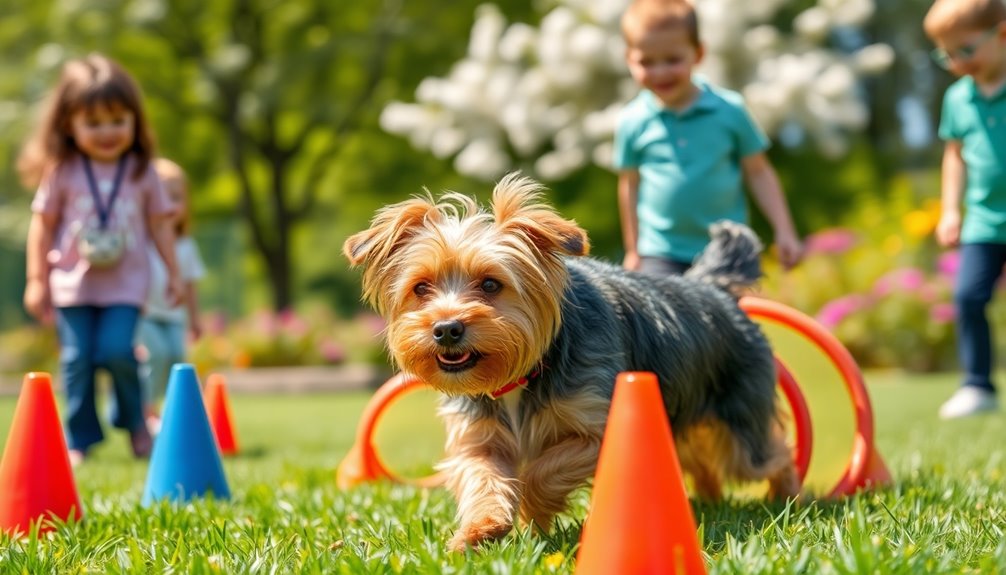
When it comes to training your Norfolk Terrier, you'll find they're moderately responsive to commands, but can be a bit stubborn at times. Gradually introducing them to new environments is essential to help them feel comfortable and confident. Keep in mind that housebreaking can be a challenge, so patience and consistency are key to success. Regular obedience training fosters a strong bond and sets clear expectations, which is crucial for their intelligent and energetic nature.
Moderately Responsive to Commands
Training a Norfolk Terrier can be a rewarding experience, but it does require patience and understanding of their moderately responsive nature. These spirited dogs respond best to positive reinforcement, so using treats and praise during training sessions is essential.
Keep sessions short, consistent, and enjoyable to maintain their interest and cooperation. Early obedience training helps establish a strong bond and sets clear expectations for behavior. Additionally, it's important to note that regular exercise contributes to their overall health and behavior management, which is crucial for their active nature.
Socialization is vital, especially when they're puppies. Expose them to new people, pets, and environments to ensure they grow into well-adjusted adults. Consider enrolling in puppy classes, which provide age-appropriate socialization opportunities while ensuring they're up to date on vaccinations.
This exposure will help manage their strong prey drive and promote harmony with other pets.
Remember that Norfolk Terriers can be independent and a bit stubborn, making training a challenge at times. Address barking issues and destructive behavior through proper training and regular exercise to expend their energy.
Consistency is key, as it aids in their physical and mental well-being, ensuring they become happy, well-behaved companions.
Gradual Introductions to New Environments
Introducing your Norfolk Terrier to new environments should be a gradual process that fosters confidence and reduces anxiety.
Start early, ideally between 5 to 16 weeks, to shape positive social behaviors. Begin with short walks around your neighborhood and gradually explore busier areas like parks. Ensure your puppy is fully vaccinated before exposing it to large crowds. Emotional regulation is crucial during this phase to help manage any stress your puppy may feel.
Use different routes on your walks to introduce various sights, sounds, and smells. Positive reinforcement is key; reward your puppy with treats and praise during these experiences to create positive associations. Early exposure is essential for developing a well-adjusted dog.
You can also invite family and friends over to help your pup meet different people in a controlled setting.
As your Norfolk Terrier grows more comfortable, consider supervised playtime at dog parks or daycare, provided they've the right temperament.
Remember, gradual introductions are crucial, especially with other pets. If you have cats, be patient, as it may take time for them to adjust to your playful puppy.
Ongoing socialization is vital throughout your dog's life.
Keep training fun and varied, continuing to expose your Norfolk Terrier to new environments and experiences. This will help ensure they remain happy and confident.
Housebreaking Difficulties
Housebreaking a Norfolk Terrier can sometimes be a challenging endeavor, but with the right approach, you can make the process smoother.
Start by establishing a consistent routine. Feed your puppy at scheduled mealtimes, and take them outside within 15 minutes after meals, naps, and playtime. Make it a habit to take them out first thing in the morning. Providing frequent opportunities for elimination is crucial for success.
Positive reinforcement is key. Use a specific phrase like "get busy" to signal elimination. Reward your pup immediately with praise and treats after they go outside. Keep your tone upbeat and ensure training sessions are short and engaging to maintain their interest.
Crate training can also aid in housebreaking. Introduce the crate positively by associating it with food and toys. Gradually close the door while your puppy is calm, and take them outside right after they exit the crate.
Ideal Living Environment
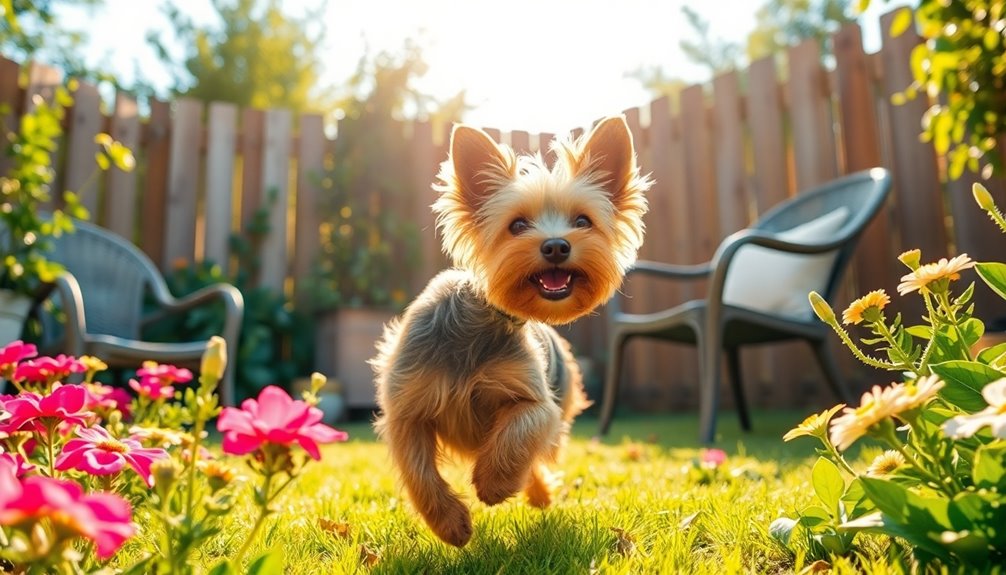
If you live in a cozy apartment or have a small yard, a Norfolk Terrier can be a great fit for you.
These spirited dogs thrive in moderate temperatures year-round and need a bit of outdoor space to run around. Additionally, their playful nature means they enjoy interactive games, which is essential for their overall well-being.
Just remember, regular exercise and mental stimulation are key to keeping them happy and engaged.
Small Yard or Cozy Apartment
Norfolk Terriers are well-suited for small yards or cozy apartments, making them an excellent choice for urban dwellers. Their small size allows them to thrive in limited spaces, but you'll need to ensure they get daily walks and plenty of playtime.
They're energetic little dogs, requiring 30 to 60 minutes of exercise each day to keep them happy and healthy. Additionally, they thrive on regular walks, games like fetch, and mentally stimulating tasks to keep their minds engaged. Providing them with interactive toys can enhance their physical and mental well-being.
While they adapt well to various living environments, you'll want to provide mental stimulation to prevent boredom. Interactive toys, agility activities, and regular play sessions can help burn off their abundant energy.
Keep in mind, they've a strong prey drive, so a secure, fenced yard is ideal if you have outdoor space.
Their alert nature means they might bark at strangers, which could be a concern in close quarters, so consider your noise tolerance.
Supervision around small animals and children is essential, as is regular grooming and dental care.
With proper care and consistent exercise, your Norfolk Terrier can thrive in a cozy apartment or small yard, bringing joy and companionship to your urban lifestyle.
Prefers Moderate Temperatures Year-Round
Most Norfolk Terriers thrive in moderate temperatures year-round, which helps them maintain optimal health and energy levels. These spirited dogs aren't built for extreme weather, so it's crucial to keep their environment comfortable.
While they can manage some heat, you'll need to ensure they stay hydrated and have access to shade to prevent overheating. Norfolk Terriers primarily cool off by panting, so monitoring their breathing, especially when temperatures rise above 81°F, is essential. Panting serves as the primary cooling mechanism for dogs, which is particularly important for keeping them comfortable in warmer conditions.
In colder conditions, their wiry double coat offers some insulation, but it's not as effective as thicker coats. They may lose body heat quickly, so providing a well-insulated indoor space is vital.
When winter hits, consider giving them extra calories to maintain energy levels, and protect their paws from ice and salt with wax or booties.
Aim for a stable indoor temperature that avoids extremes. Adjust the thermostat based on your dog's comfort level, and create spaces where they can either warm up or cool down.
Famous for Their Ratting Skills
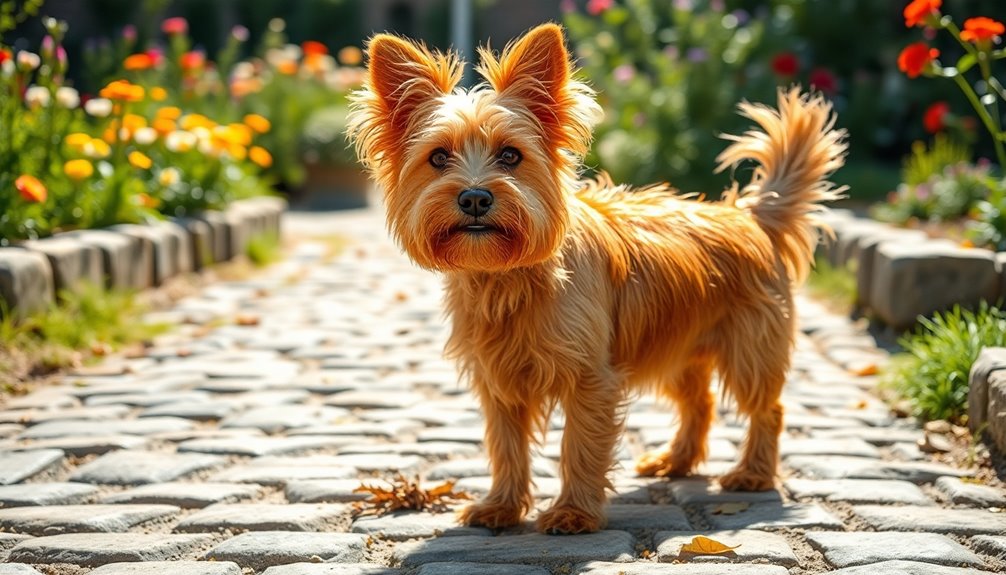
Norfolk Terriers are exceptional diggers and burrowers, making them natural ratters. Their skills not only helped control rodent populations but also earned them a spot in popular culture, as seen in "The Queen's Gambit." You'll find their spirited nature and agility hard to resist! Their origin as ratters in East Anglia highlights their historical significance in agricultural settings.
Exceptional Diggers and Burrowers
Renowned for their exceptional digging and burrowing skills, the Norfolk Terrier excels as a vermin hunter. Bred specifically to hunt vermin living in underground dens, these spirited dogs were once the go-to companions for itinerant rat catchers, helping to rid farms of pests. Their small size allows them to fit into narrow burrows and tunnels, making them effective solo hunters or capable team players in packs.
In modern times, Norfolk Terriers participate in Earthdog trials, navigating man-made tunnels to scent and work quarry like rats. They also engage in Barn Hunt events, showcasing their instinctive skills in farm-like settings filled with straw and tubes. Their natural digging instincts can turn into a nuisance if they aren't adequately exercised, as they might dig in your garden or yard. Additionally, they require daily exercise to prevent boredom and destructive behaviors.
However, when trained effectively, these dogs work well in groups with other breeds to control pests. Smaller Norfolk Terriers use their keen noses to mark and chase rats, while larger breeds provide support. This training not only utilizes their hunting instincts but also offers excellent physical and mental stimulation for these intelligent dogs.
Norfolk Terrier in "The Queen's Gambit
In the captivating world of "The Queen's Gambit," you might've spotted the Norfolk Terrier, a breed celebrated for its remarkable ratting skills. Originating in 19th-century England, these spirited dogs were bred by farmers and hunters specifically to catch small critters like rats and foxes. Their compact size, typically standing 9 to 10 inches tall and weighing around 11-12 pounds, allows them to navigate tight spaces with ease.
Norfolk Terriers possess a strong, wedge-shaped muzzle and large teeth, making them efficient hunters. Their fearless and alert nature, characteristic of true terriers, means they're always ready to tackle a challenge. Whether working solo or in a pack, they demonstrate loyalty and intelligence, making them effective team players during hunts. The breed's substantial and hardy body structure further enhances their ability to endure rigorous work in various environments.
Even in modern times, Norfolk Terriers are still utilized for environmentally friendly pest control. They thrive when trained in real-world hunting scenarios, although it may take a year or two for them to fully recognize their skills.
Their gregarious nature makes them a joy to have around, whether in the field or at home, showcasing their versatility and charm.
Energetic Companion for Active Owners?
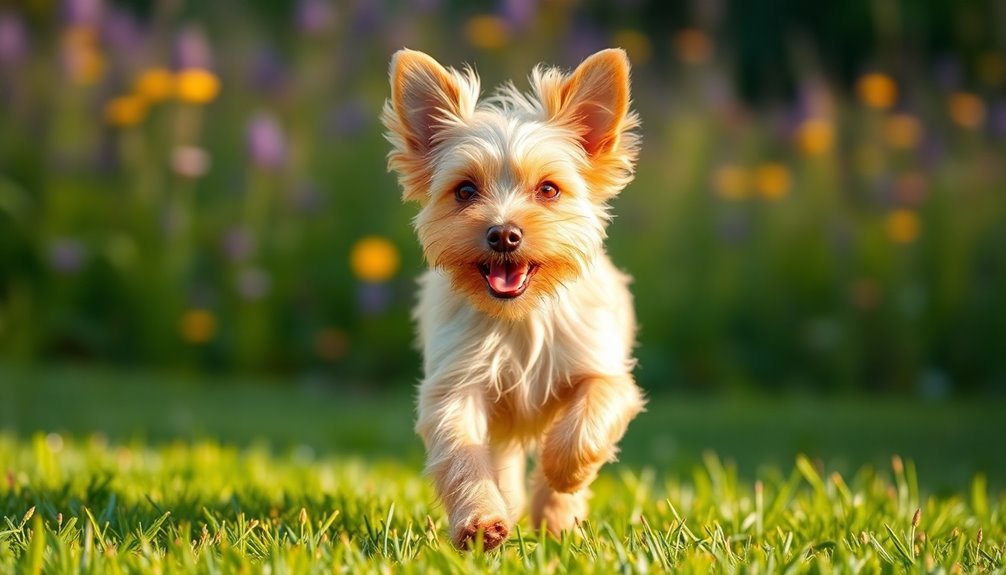
If you lead an active lifestyle, a Norfolk Terrier could be the perfect companion for you.
With daily exercise needs of 30 to 60 minutes, they thrive on walks, playtime, and mental challenges. Regular activity is crucial as it can help reduce behavioral issues stemming from boredom. Additionally, incorporating nutrient-rich foods into their diet can further enhance their energy levels and overall well-being. Just remember, regular grooming and maintenance are essential to keep them healthy and happy.
Ideal for Active Lifestyles
Norfolk Terriers are often the perfect match for active owners looking for a spirited companion. With daily exercise needs ranging from 30 minutes to an hour, they thrive on walks, short jogs, and interactive play.
Whether you're playing fetch, tug of war, or setting up agility courses, these activities provide both physical and mental stimulation, keeping your Norfolk engaged and happy.
To build endurance, gradually increase the distance during outdoor adventures. Consider canicross for a more adventurous outing, or mix things up with puzzle toys and hide-and-seek games. These little dogs love to explore, but always supervise their playtime due to their strong hunting instincts.
Norfolk Terriers adapt well to various living situations, from cozy apartments to spacious homes, as long as you maintain a consistent activity level. Socializing them through different walks and times of day enhances their well-being.
The key to keeping them content is ensuring they've enough mental stimulation, as boredom can lead to undesirable behaviors. With positive reinforcement training, you can harness their energetic nature into fun, structured activities that strengthen your bond.
Grooming Needs and Maintenance
For a spirited companion like the Norfolk Terrier, grooming is essential to keep your dog looking and feeling their best.
You'll want to invest in a slicker brush to remove loose hair and debris, and a comb with fine and wide-toothed sides to tackle any tangles. Regularly trimming around their eyes, ears, and muzzle with grooming scissors helps maintain a tidy appearance, while thinning shears can help manage thicker areas of their coat.
Bathing every 4-6 weeks is key to a clean coat, but make sure to use a strong, dog-safe shampoo without conditioners to avoid drying out their wiry fur. Hand-stripping is necessary to keep their outer coat in top shape, and using hypo-allergenic shampoo is recommended due to their allergy susceptibility.
Establish a grooming routine by brushing your Norfolk Terrier once or twice a week, checking for mats, and trimming the hair around their paws.
Don't forget to clean their ears regularly and brush their teeth to prevent dental issues. In dry climates, Aloe Hydrating Spray can keep their skin moisturized, while paw balm protects their pads.
With proper grooming, your Norfolk Terrier will remain a vibrant and healthy companion!
Frequently Asked Questions
How Much Do Norfolk Terriers Typically Weigh?
Norfolk Terriers typically weigh between 11 and 12 pounds, regardless of gender.
You might find some variability, with the heaviest individuals reaching up to 22.7 pounds and the lightest around 11.7 pounds.
They usually reach their full size around 6 to 8 months old, so if you're considering one, keep an eye on their weight to maintain optimal health.
Regular exercise and a balanced diet are key to preventing obesity in these spirited dogs.
Are Norfolk Terriers Good With Children?
Yes, Norfolk Terriers are generally good with children.
They're patient and enjoy playtime, making them great companions for active kids. However, you should supervise their interactions to ensure everyone's safety and comfort.
Teach your kids how to interact gently, as the dog's small size makes them vulnerable to rough handling.
With early training and socialization, they'll get along well with children and other pets, creating a fun, loving environment for your family.
What Is the Average Lifespan of a Norfolk Terrier?
The average lifespan of a Norfolk Terrier ranges from 12 to 16 years, with many living into their late teens.
A recent study found an average life expectancy of 13.5 years in the UK.
You can help extend their lifespan by providing proper care, a healthy lifestyle, and regular veterinary check-ups.
Be aware of common health issues like Mitral Valve Disease and Luxating Patella, as early detection is key to ensuring your dog's longevity.
Do Norfolk Terriers Shed a Lot?
Norfolk Terriers don't shed a lot, which is great if you prefer a clean home.
Their wiry double coat sheds minimally, and you'll find that it requires regular maintenance.
You'll need to brush them weekly to prevent matting, and stripping or clipping every six months is essential.
Keeping up with their grooming not only keeps their coat healthy but also helps you monitor their overall well-being.
Can Norfolk Terriers Adapt to Apartment Living?
Yes, Norfolk Terriers can adapt to apartment living, especially if you provide enough exercise and mental stimulation.
They need daily walks of 30 to 60 minutes and enjoy playtime in secure areas.
While they thrive in active households, having access to outdoor space or a secured yard enhances their well-being.
Just be sure to engage them regularly to keep them entertained and prevent any boredom-related behaviors.
Conclusion
In conclusion, the Norfolk Terrier is a spirited and friendly companion that thrives in an active household. With their charming personality and impressive ratting skills, they make for delightful pets who love to engage in play and exploration. By providing proper training and socialization, you'll foster a strong bond with this energetic little dog. If you're looking for a loyal, lively addition to your family, the Norfolk Terrier might just be the perfect fit for you!


